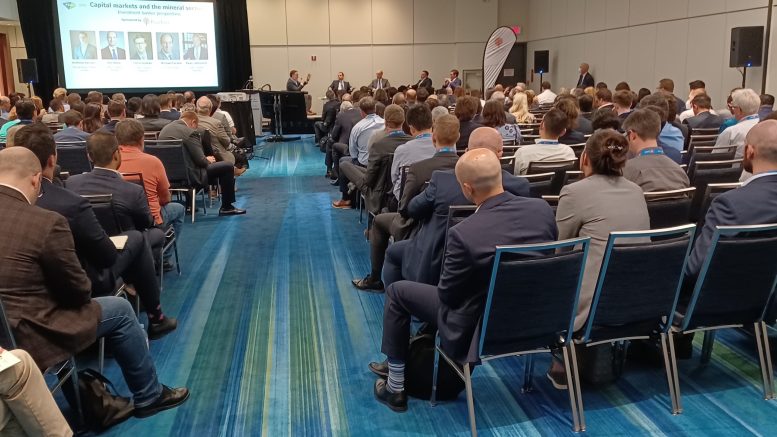Despite strong commodity prices, money has not been flowing into the mining sector — and that is likely to be the case as long as market volatility and uncertainty continue, according to a panel of mining-focused investment bankers at this week’s Prospectors and Developers Association of Canada (PDAC) convention.
The June 13 conversation, moderated by Northern Miner Group president Anthony Vaccaro, took place in the context of a market selloff with the market reacting to higher than expected inflation numbers in the U.S. and growing recession fears.
Michael Faralla, head of TD Securities’ Global Mining Group, noted that financings on the Toronto Stock Exchange are down roughly 60-70% from last year. “That’s not a mining issue per se — that’s a broader market volatility and risk-off attitude amongst investors issue,” he said. “The mining sector has been caught up in that, even with high commodity prices.”
“The concern is the data is all over the place,” said CIBC Capital Markets’ Chris Gratias, adding that there has also been a lack of consensus on how the U.S. Federal Reserve will respond to rising inflation.
“The fact that we had close to 9% inflation in the U.S. surprised a lot of people,” Gratias said – pointing to inflation numbers, released on June 10, as the reason for the market fall on June 13. “All of a sudden you go from the Fed changing rates from 50 basis points in the next meeting to people saying 75, which is huge.”
Summing up, he said: “I think that’s just the environment for a while yet… and in a period of volatility and uncertainty, what do people do? They sit on their hands.”
Although producing companies are in a healthy position now, thanks to previous years of cost cutting and robust commodity prices, they now face the challenge of inflation — in wages, consumables and other input costs.
“We’ve seen over the last half a dozen years mining companies doing a really good job of containing costs and returning free cash flow to the shareholders, and now we’re seeing a countervailing trend of costs going up because of external factors,” Faralla said. “So I think that’s another headwind for the mining sector generally.”
‘Uptick in capital’
Despite the current aversion to risk, concerns around electrification and decarbonization have “radically awoken” people to how much demand for metals is actually growing, said Ryan Latinovich of RBC Capital Markets.
“What we’re seeing now, I think, is increasing awareness of the fact that the supply side — i.e., the miners, that provide these materials — is exceptionally constrained,” he said. ”So where’s all this material going to come from?
“I personally hope, especially with Canada at the epicentre of resource wealth and near the biggest auto market in the world, that we’re actually going to see an uptick in risk capital for the mining space as people start to try to get ahead of what is in any model a looming shortage on supply of these metals,” Latinovich said.
In that vein, the panellists also discussed what it will take to get investment flowing back into the mining space.
CIBC’s Gratias noted that at the end of the last cycle, which ended in 2012, there were a lot of specialty mining funds that played a major role in capital formation supporting the sector.
“Fast forward to today — there are half as many specially running funds with one quarter of the capital,” he said. While Gratias believes that money will come back, he said that we’re starting from a smaller base than in previous cycles.
“For money to return to the space, we need to see generalist investors re-weight to the space and I think we would all say that across the globe, generalist investors are underweight the mining sector,” he said. “If you’re a generalist investor and everything else is working well – as we’ve seen for the last five or six. years in the equity markets… why change something that’s working?”
Ilan Bahar of BMO Capital Markets agreed: “It’s been much too easy to make money elsewhere.
“Any extractive industry has its risks,” he said. In addition to commodity price risk, inflationary risks have now come to the fore.
While the panel was not optimistic about inflows of capital returning to mining in the near-term, defined as roughly 12 months, they were bullish over the medium to long-term.
M&A & the Aussies
The panel also discussed the strong and notable trend that has emerged in the past three to four years of Australian companies acquiring assets in Canada.
“I actually think we would have seen more if it weren’t for Covid. The Aussies were extremely active and then it became very hard for them to travel and do diligence,” said Bahar, who noted that judging by the smiles in the room when the topic came up, “I think the Aussies are here in the room.”
He pointed to a couple of reasons for the trend, which he believes is going to continue.
“There’s clearly better momentum in their capital markets around mining. It’s easier to raise capital, in some cases the multiples are stronger. There has been, broadly speaking, greater institutional investor support for M&A,” Bahar said. In the Canadian markets, on the other hand, there’s often been some criticism around M&A, and therefore less support for deals.
The other reason, he said, is specialized expertise.
“Some of the companies have a real core competency, something that makes them special and different, and if they apply their managerial style, you know — underground mining, a skill set that’s been developed over decades or something like that they can bring here and achieve a better outcome, and that’s been supporting their base strategy.”


Be the first to comment on "PDAC 2022: Investment bankers see capital returning to mining – once market risks abate"